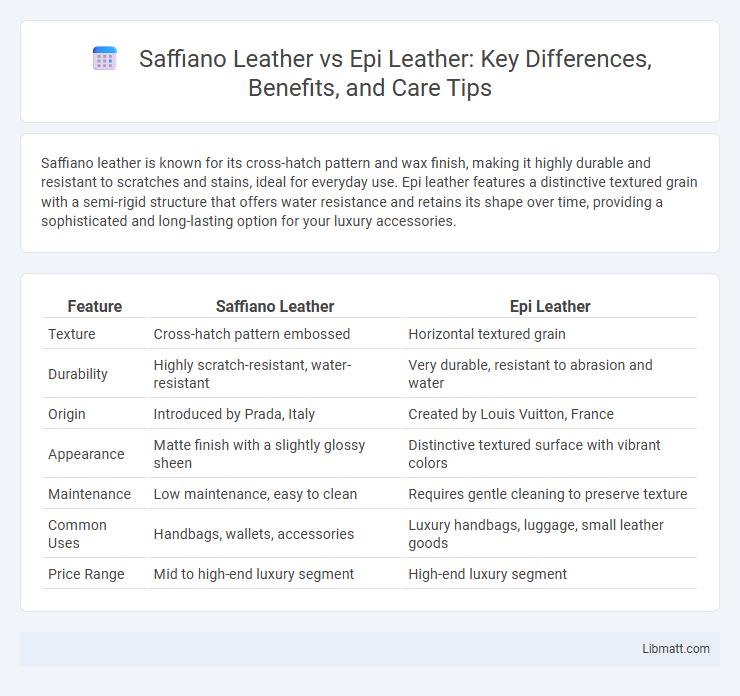Saffiano leather is known for its cross-hatch pattern and wax finish, making it highly durable and resistant to scratches and stains, ideal for everyday use. Epi leather features a distinctive textured grain with a semi-rigid structure that offers water resistance and retains its shape over time, providing a sophisticated and long-lasting option for your luxury accessories.
Table of Comparison
| Feature | Saffiano Leather | Epi Leather |
|---|---|---|
| Texture | Cross-hatch pattern embossed | Horizontal textured grain |
| Durability | Highly scratch-resistant, water-resistant | Very durable, resistant to abrasion and water |
| Origin | Introduced by Prada, Italy | Created by Louis Vuitton, France |
| Appearance | Matte finish with a slightly glossy sheen | Distinctive textured surface with vibrant colors |
| Maintenance | Low maintenance, easy to clean | Requires gentle cleaning to preserve texture |
| Common Uses | Handbags, wallets, accessories | Luxury handbags, luggage, small leather goods |
| Price Range | Mid to high-end luxury segment | High-end luxury segment |
Introduction to Saffiano and Epi Leather
Saffiano leather is characterized by its cross-hatch pattern and wax finish, making it highly durable and resistant to scratches and water. Epi leather, developed by Louis Vuitton, features a textured, horizontal grain that offers both elegance and robust wear. Both materials are prized for their longevity and distinct aesthetic appeal in luxury fashion accessories.
Origins and History of Saffiano Leather
Saffiano leather originated in Milan, Italy, developed by the luxury fashion house Prada in the early 20th century. This distinctive leather features a crosshatch pattern pressed onto the wax-coated surface, offering durability and water resistance that elevated its appeal in high-end accessories. Its innovative texture and functionality quickly made Saffiano leather a hallmark of premium craftsmanship in the luxury goods market.
Origins and History of Epi Leather
Epi leather originated in 1951 when Louis Vuitton introduced this textured, durable material characterized by its horizontal, wave-like grain pattern, designed to combine luxury with practicality. Crafted from high-quality cowhide, Epi leather undergoes a unique stamping and dyeing process, resulting in a water and scratch-resistant finish that has become iconic in the fashion industry. Your choice between Saffiano and Epi leather hinges on appreciating Epi's rich heritage rooted in mid-20th-century French leather craftsmanship and its enduring appeal for sophisticated, long-lasting accessories.
Unique Manufacturing Processes
Saffiano leather is crafted through a distinctive method involving the stamping of a cross-hatch pattern onto the leather's surface, which is then coated with a wax finish to enhance durability and water resistance. In contrast, Epi leather undergoes a unique embossing process that creates a textured, horizontal wave-like pattern, typically applied to full-grain leather and finished with a resilient protective lacquer. These manufacturing techniques not only define the signature aesthetics of Saffiano and Epi leather but also contribute significantly to their robustness and longevity.
Texture and Appearance Comparison
Saffiano leather features a crosshatch pattern pressed into the wax-coated surface, giving it a structured and slightly glossy appearance that resists scratches and stains. Epi leather has a distinctive, slightly textured horizontal grain with a matte finish, known for its durable and water-resistant qualities. While Saffiano offers a more polished and uniform look, Epi leather's unique texture provides a subtle, natural variation in appearance.
Durability and Resistance
Saffiano leather features a tightly pressed crosshatch pattern coated with a wax finish, making it highly resistant to scratches, water, and stains while maintaining its durability over time. Epi leather, crafted from grained cowhide with a textured, horizontal pattern, offers robust resistance to abrasion and water, ensuring long-lasting wear and minimal signs of aging. When choosing between the two, your decision should consider that Saffiano excels in scratch and stain defense, whereas Epi leather provides exceptional toughness against everyday wear.
Maintenance and Care Tips
Saffiano leather requires gentle cleaning with a damp cloth and occasional conditioning to maintain its signature crosshatch texture and prevent dryness. Epi leather is more water-resistant and durable, needing only mild soap and water for routine cleaning without frequent conditioning. Knowing these care differences helps you prolong the lifespan and appearance of your luxury leather accessories effectively.
Popular Brands Using Saffiano and Epi Leather
Saffiano leather is prominently used by luxury brands such as Prada and Michael Kors, known for its crosshatch texture and durability. Epi leather, favored by Louis Vuitton and Hermes, features a distinctive textured surface that enhances scratch resistance and flexibility. Both leathers are celebrated in high-end fashion for their unique finishes and longevity, making them staples in premium accessory collections.
Price Differences and Value
Saffiano leather typically commands a higher price than Epi leather due to its intricate crosshatch pattern and durable treatment, which enhances scratch resistance and longevity. Epi leather offers solid value for those seeking a textured, water-resistant material with a more affordable price point, making it ideal for everyday luxury. Your choice depends on balancing the premium cost of Saffiano's refined finish against the practical durability and wallet-friendly nature of Epi leather.
Which Leather Should You Choose?
Choosing between Saffiano and Epi leather depends on your preference for texture and durability. Saffiano leather, known for its crosshatch pattern and scratch-resistant coating, offers a sleek, polished look ideal for everyday use. Epi leather features a distinctive grain pattern that resists water and wear, making it perfect for those seeking a more rigid yet flexible material.
Saffiano leather vs Epi leather Infographic

 libmatt.com
libmatt.com